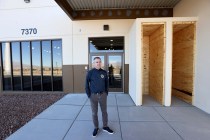Authority spokesman says valley has water for new housing
It began almost four months ago with a column in this corner that questioned how the development of new homes in Summerlin — and indeed new housing in all of Southern Nevada — can continue at the pace it has for decades in light of the mother of all droughts continuing to plague the Southwest.
Throw into the mix the fact that the water level in Lake Mead has been receding at a pace almost comparable to your bathtub after you've unplugged the drain. And keep in mind that Lake Mead is where more than 90 percent of our water comes from, via the Colorado River.
Add to the same mix the haunting fears of Gov. Brian Sandoval, who doubled down his concern over the seriousness of the drought in no uncertain terms when he kicked off a recent water summit in Carson City.
But it was my column, which appeared in the View last July 9, questioning the ability to provide sufficient water to accommodate about 40,000 new homes to satisfy the master plan envisioned by The Howard Hughes Corp., developer of Summerlin, which triggered an email from Bronson Mack.
Mack is a well-respected and highly informed spokesman for the Southern Nevada Water Authority. His email invited me to hear the water authority's side of the story, one that insists there will be more than sufficient water in the Las Vegas Valley to support fulfillment of Hughes Corp.'s master plan.
In fact, Mack asserted there will be enough water to provide housing for more than a million additional new residents to the valley over the next couple of decades, irrespective of any continuation of the drought coupled with the liquidation of liquid in Lake Mead. Moreover, he stated, "There is no correlation of the declining levels in Lake Mead to the use of water."
That's because one of the more illuminating observations Mack made was that "Southern Nevada reclaims almost 100 percent of black water." For the unenlightened, that's wastewater, right out of the sewer pipes.
"Our treatment plants are capable of reclaiming that water," Mack said, in as convincing a tone as possible. "Fortunately, our water treatment facilities are state-of-the-art. In addition, we meet or surpass all water purification standards."
It all began with intensive conservation efforts from the get-go, Mack explained, adding, "The drought started in 2002, and Nevada reacted quickly with a comprehensive water conservation program. Since then, there has been a 30 percent drop in water use, while at the same time the population has increased by 520,000."
He said the prohibition of grass in new housing developments, combined with incentives to remove existing grass, were fundamental elements in a new conservation code.
"Specific to Summerlin, codes now exist for constructing water-efficient structures that meet standards which are more effective than those used in the 1990s," he said. "Toilets, sinks and showers are now more efficient, and there are high-efficiency washing machines."
He said those are just samples of the advances that have impacted the kind of development that will allow population growth in Southern Nevada to continue unimpeded.
Mack produced numbers on water usage to show that development in Summerlin or any other section of Southern Nevada will not suffer from insufficient amounts of water.
"In fact, our water resources plan should meet the demand over the next half century," he said.
"For example, if shortages are declared on the Colorado River," he said, citing such a possibility in 2017, "Southern Nevada will be able to use only 280,000 acre-feet of its present 300,000 acre-feet annual allocation. But, at present, our community is using only 225,000 acre-feet of water. So we could absorb such a temporary shortage without having any impact on our ability to meet demands."
You might ask, what exactly is one acre-foot of water? Mack explained that "325,851 gallons is one acre-foot, which is enough water to supply two average homes for about 14 months."
As a result of the water authority's conservation program, combined with the treatment of black water, "We have more than 1.5 million acre-feet of water now sitting in bank storage," Mack said. It's contained in the same underground aquifers that have stored rain and snowpack water for millions of years.
— Herb Jaffe was an op-ed columnist and investigative reporter for most of his 39 years at the Star-Ledger of Newark, N.J. His most recent novel, "Double Play," is now available. Contact him at hjaffe@cox.net.

















